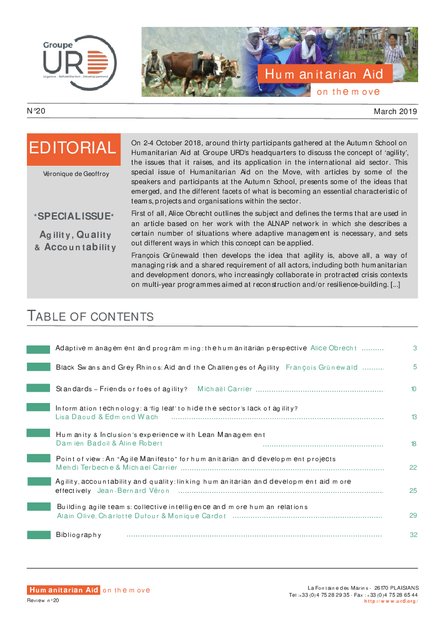
On 2-4 October 2018, around thirty participants gathered at the Autumn School on Humanitarian Aid at Groupe URD’s headquarters to discuss the concept of ‘agility’, the issues that it raises, and its application in the international aid sector. This special issue of Humanitarian Aid on the Move, with articles by some of the speakers and participants at the Autumn School, presents some of the ideas that emerged, and the different facets of what is becoming an essential characteristic of teams, projects and organisations within the sector.
First of all, Alice Obrecht outlines the subject and defines the terms that are used in an article based on her work with the ALNAP network in which she describes a certain number of situations where adaptive management is necessary, and sets out different ways in which this concept can be applied. François Grünewald then develops the idea that agility is, above all, a way of managing risk and a shared requirement of all actors, including both humanitarian and development donors, who increasingly collaborate in protracted crisis contexts on multi-year programmes aimed at reconstruction and/or resilience-building.
Different concrete examples are then explored in relation to programme agility. First of all, by looking at increasing accountability demands and changes to the aid system, such as the implementation of standards and the increasing use of information technology: do they increase, or, on the contrary, limit our capacity to ‘be agile’? These are the questions raised by Michaël Carrier in his article, ‘Standards – Friends or foes of agility?’, and by Lisa Daoud and Edmond Wach in, ‘Information technology: a ‘fig leaf’ to hide the sector’s lack of agility?’ Similarly, agility is an issue at stake for organisations that have grown and whose internal structure has changed a lot in recent decades. Thus, Damien Badoil and Aline Robert describe the current experience of Humanity & Inclusion in using ‘Lean Management’ tools and methods to simplify their internal processes.
Then, in the ‘Point of view’ section, Medhi Terbèche and Michaël Carrier argue that the objectives of agility and quality can only be achieved by respecting a certain number of good practices, and they suggest that a loose adaptation of the ‘Agile Manifesto’, which was drawn up by software developers in 2001, could be used by the aid sector. Jean-Bernard Véron, for his part, takes us back to the field where an aid programme in Northern Mali has managed to achieve its objectives by putting agility and accountability towards the beneficiaries into practice – ahead of its time? When project management is based on knowledge of the context and the actors involved, flexibility and relations with the population, high quality results tend to follow.
The last facet of our kaleidoscope is the question of how to manage agile teams, as explored by Alain Olive, Charlotte Dufour and Monique Cardot. Over and above the important operational issues that this question raises is the fundamental question of the place of human beings in complex organisational systems, and the ability of the humanitarian sector to go back to what motivated its existence in the first place.